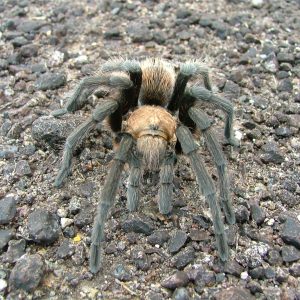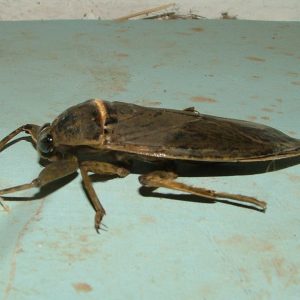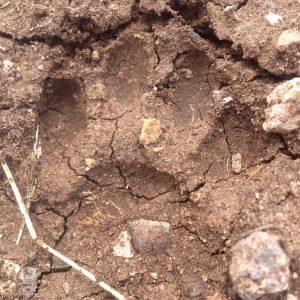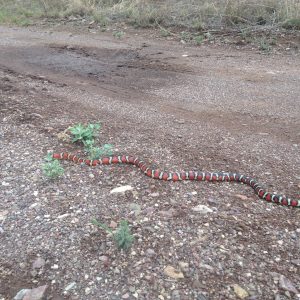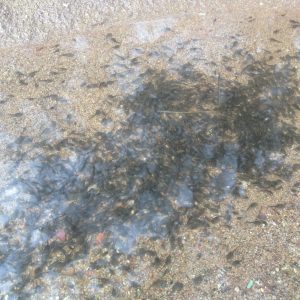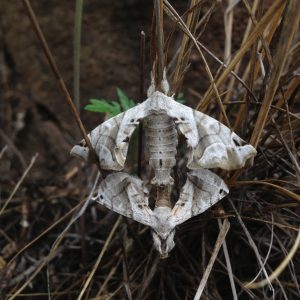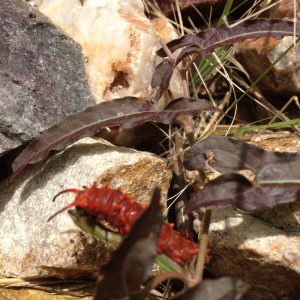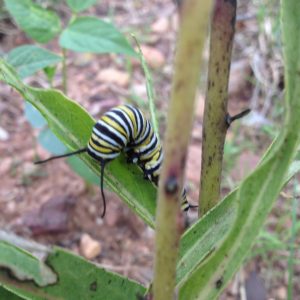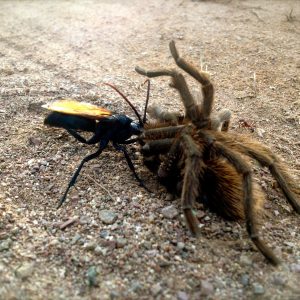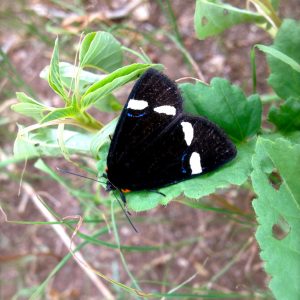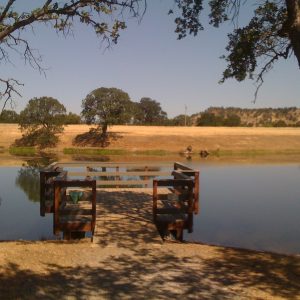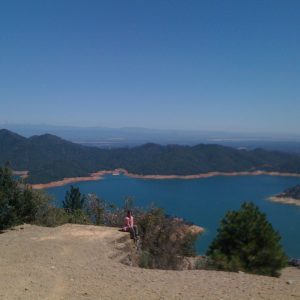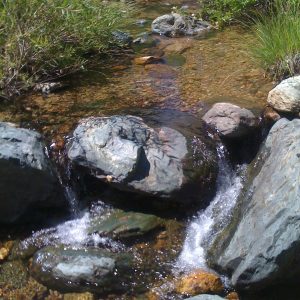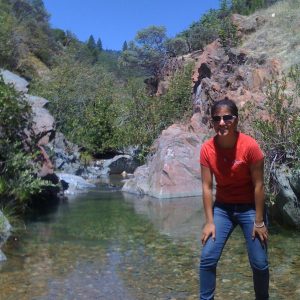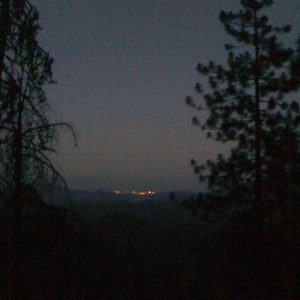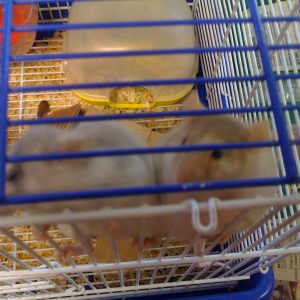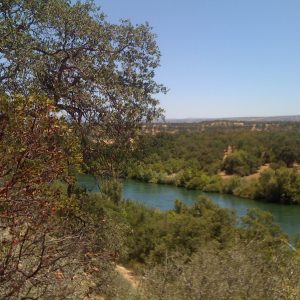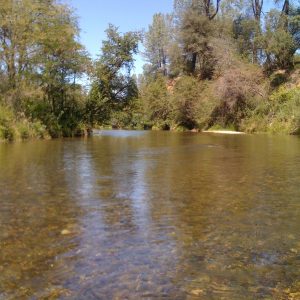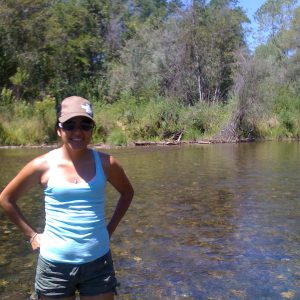Hello from Twin Falls Idaho! these past two months of this internship have been a great learning experience for me. I have learned so many skills that I will be useful for me in the future when I am looking for a career. The crew has
helped me in more ways than I can imagine without them I would have no idea what I was doing or if I was doing it correctly. Just last week we explored all over the field office and as a result we traveled down to the Bruneu River Wilderness and looked for the Bruneu River Phlox which only grows in this area along steep cliff walls. However, in order to get to the river we had to take a grueling 3 hour drive through the entire field office which eventually led to the Bruneu River Cherrystem which is as steep and rocky of a road as you can get. After taking some pictures from the top of the canyon we descended the slope and made it to the river. We all put on our life jackets and waded downstream to look for the elusive phlox. The life jackets were necessary in order to cross the deeper holes. However, after looking all day we could not find any sign of the phlox and we had to head back home. It was a great trip and I’m glad I got to see more of the area I am working and still find ways to enjoy this type of work. I’m very grateful for the opportunity to work through the CLM program and I know that all of this hard work and experience will pay off.
Monthly Archives: August 2013
Falcons, Caribou, and Bears (Oh My!)
Loyal readers: I bring you a quick update from the Fairbanks District Office of the Bureau of Land Management’s invasive plant management efforts.
Last week, I went on a float trip on the Fortymile River with my mentor Ruth, for the purpose of carrying out invasive plant surveys. Our survey sites were BLM designated long-term campsites. The sites are used by gold miners (yep, it’s still a thing here) who have claims on the river. If ever you are struck by an urge to really experience the Last Frontier in all its grit and glory, go find yourself some Alaskan gold miners. Nice folks, really; just don’t mind the 45 caliber pistol on their hip.
No news is good news, at least in the case of this trip, and we found no non-native plants at any of the campsites! We therefore collected “absence data” on Trimble GPS devices to submit to the National Invasive Species Information Management System (NISIMS). In the event that these areas subsequently do become infested with non-native plants, the absence data will provide valuable baseline references; dates after which such infestations must have originated.
The Fourtymile is a beautiful river, and my mentor Ruth tells me that she set a personal record for wildlife sightings on this trip. Our totals for the four-day float are as follows: two moose (mother and calf), twelve American Peregrine Falcons (my favorite bird!), one beaver, one black bear cub, two marmots, approximately seventy five caribou, assorted song birds and insects, and of course a plethora of spectacular flowers 🙂
Aside from the best float trip ever, my work recently has focused on other invasive plant surveys and weedpulls. I have surveyed and removed Melilotus officinalis (white sweetclover) and Vicia cracca (bird vetch) on major highways and other points of anthropogenic disturbance. When it comes to invasive plant management strategies in AK, you just can’t beat good ol’ manual removal! A little elbow grease. It builds character.
The Arid Sky Islands Come to Life
The winds have shifted and saturated skies swirl amongst the Madrean Archipelago of southeastern Arizona and northeastern Sonora. The onset of monsoon season has redefined life in the Sky Islands. The month of rain has nourished this corner of world with over 8 inches of rain – nearly half of the year’s precipitation. The monsoon season started with a bang, dumping 4.69” of rain in 24 hours after receiving 0.12” of rain in 4 months. This incredible display of moisture has metamorphosed the crispy, golden grassland into soft, verdant rolling hills. But plants aren’t the only creatures responding to dampness.
As I travel around Santa Cruz County collecting seeds and restoring vegetative regimes, I encounter what this land is best known for – diversity. I find myself turning entering the mindset of a National Geographic photographer and recollecting factoids from college animal behavior courses. One day a Sonoran Mountain Kingsnake slithered in front of my car, reminding me that when red stripes touch black you’re OK Jack but when red touches yellow, you’re a dead fellow. Another time, I was hiking around the wilderness collecting seed and I encountered a mountain lion footprint. Seeing this evidence of this top predator reminded me of the grandeur of the natural world. The work that I am doing lays the groundwork for ecological restoration of the smallest species but will one day affect top predators such as the mountain lion.
Another time I was walking my dog along a rural road in Patagonia when I encountered a pool filled with swirling life. Upon a closer inspection, I realized that they were tadpoles numbering in hundreds if not thousands, swirling in spirals like schools of fish. I thought of the ephemeral nature of these creatures, how they must complete their aquatic stage of life before the puddle dried up. What adaptations to the seasonal abundance!
However, encountering the abundance of pollinators has been most exciting for me this season. I’ve been living and working in Patagonia for the past year, in an effort to increase the habitat for bees, hummingbirds, butterflies, moths, bats, etc. Being able to witness the pollinators emerge and thrive has afforded me a fantastic opportunity to appreciate my work. I’m excited to continue documenting these creatures and their ecological niche on Borderlands Habitat Restoration Initiative’s Facebook page.
Midsummer update from Big Thicket
The Never-Ending Story of Bromus
It’s official: my least favorite plant of all time is Bromus madritensis. Wait no, make that ANY Bromus species! They are all equally evil! I thought I had escaped Bromus handling forever after our field season ended a few weeks ago. Boy was I wrong! Apparently you have to check, recheck, fix, and refix all collected annual plant samples….and since most of the samples were Bromus, guess what I’ve been doing for the past week straight????? GAH!!!!
End rant.
That being said, with a little help from my friends, I should hopefully really be done with Bromus handling in the next day or two. Then I can start the cool stuff! Our mentor is really excited about analyzing all the data we’ve collected while we were here, and she’s given each of the four of us interns a project or two to work on data-wise. My project is to analyze measurements of ambrosia to see if there are any morphological differences between source populations or seed transfer zones across the Mojave. Our mentor used an ordination test to check this but it showed depressingly little. So I’m going to go back and run your basic ANOVA test on the measurements individually with the stats program, R. I’ve dabbled a bit with the program (I got it to make a pretty graph!), but this will be my first real experience with statistical programs and analysis and I’m really excited about it! It’s actually a little embarrassing how excited I am about it…so everybody cross your fingers for me so I finish all the stupid Bromus soon and get to the R programming!
In closing, I would just like to remind those of you in monsoon areas to keep an eye out. Stay out of washes during flash flood watches! Storms are cool (I actually witnessed a palm tree burn after it got hit by lightning last week), but floods are bad, mkay? Stay safe out there!
Jarbidge Field Office
 Hello from Southern Idaho. We have been camping for three weeks in the Jarbidge Field Office at Buck Flat Well. My Mentor Pattie Jo Courtney assigned me crew lead and this is my fabulous crew. From left to right, Dan, Me (Lori Shafer), Holt, and Kent. We enter all of our data on the lap top or toughbook, this makes uploading to the data base a breeze when we get back to the office. I am having a great time and love working in the field. Everyday is an adventure.
Hello from Southern Idaho. We have been camping for three weeks in the Jarbidge Field Office at Buck Flat Well. My Mentor Pattie Jo Courtney assigned me crew lead and this is my fabulous crew. From left to right, Dan, Me (Lori Shafer), Holt, and Kent. We enter all of our data on the lap top or toughbook, this makes uploading to the data base a breeze when we get back to the office. I am having a great time and love working in the field. Everyday is an adventure.
Wrapping up Upland Trend
Hello from Idaho… We wrapped up today with our last upland trend site. The forbs are getting dry and a little hard to identify. We will be continuing our HAF sites for sage grouse, which we only identify perennial forbs. These sites are further south in higher elevation and the forbs are still plentiful and fairly easy to id. Next week we are going to Indian Hot Springs and looking for a special status plant, Epipacits gigantea the common name is chatterbox orchid. We have to float the Bruneau River to properly scan the entire area along the reach. Looking forward to it, until next time.
Eastern Oregon, full of surprises!
There has been a lot of work accomplished these past two months, and a lot of knowledge gained. Aside from the regular schedule of scouting for new seed collections, collecting seed, and monitoring sensitive plants; I have been given the opportunity work on different projects and with people from many different organizations.
1) Hells Canyon: The botanist in the Northern Resource Area of Vale District needed help collecting a sensitive plants seeds for conservation purposes. Rubus bartonianus – which is Bartonberry – is endemic globally to Hells Canyon along the Snake River. The other intern, the botanist, and I had to climb steep talus slopes to collect the berries, and it made for a very tough hike. The views were amazing, and we stumbled upon an abandoned mine. Didn’t fall in, luckily (thanks for the heads up CLM training workshop).
2) Traveled to the Nevada border to monitor Emergency Rehabilitation and Stabilization trend plots for a fire that consumed nearly 500,000 acres of shrubland last July. The point of monitoring the plots is to determine when the land is stable and ready for grazing to be allowed back on the land.
3) One of the most informative weeks of the internship was the week I got to help out an ID team with Geographic Management Area standards and guideline monitoring. An ID team of a hydrologist, botanist, horse and burro specialist, wildlife tech, and Range Conservationist were put together to interpret rangeland health through qualitative indicators. The objective was to gather information at the site, determine the health at the time, and if the land was degrading due to grazing: determine what method should be used to monitor the change, and if needed, use adaptive management to improve land. Overall, I loved this week most because it brought together much of what I have been learing the months I have been here. Also, a comprehensive overview of the purpose of the BLM was made clear to me this week.
4) Hunt Mountain: This was another great week for learning and working with people from other federal agencies other than the BLM. There was a collaborative effort between the Forest Service, a private contractor, and the BLM to monitor Blister rust (Cronartium ribicola) on White bark pine (Pinus albicaulis). We set up transects on Hunt Mountain and followed a particular protocol for determing if there was blister rust present and the severity of it on the white bark pines. Hiking up to 7200 ft on Hunt Mounatin was definitely worth it.
So far I have gained a tremendous amount of knowledge, and cant wait to learn more! The amount I have written in this blog is only a small portion of what I have learned.
Hells Canyon, Oregon
Windy Bugs — Insect processing!
In the last couple of weeks, we resampled our Sierra Madre and Choke Cherry sites. The trips were pretty fast since we have our system down, and other than a couple rebar stakes damaged by cattle, uneventful.
We have been spending a good amount of time processing insect samples in the lab. I enjoy this task and find it relaxing. Once you settle into a groove, the pinning goes very fast and I am always amazed by the beauty of the insects.
Pinning is an art and always done with full respect to the animals. While it is difficult for me to actively (and passively) kill so many insects, I am happy to be part of a conservation project and be able to document the insects in an understudied area. I also enjoy handling and identifying them. After collection in the field, the insects are stored in whirlpaks until we can process them in the lab. They are cleaned, sorted, and lovingly pinned, then stored until the field season is over, when I will start to identify them.
Next week will bring another field trip to Sierra Madre and pinning, as well as recreational enjoyment of the fading Wyoming summer. Being on a college campus and watching students trickle back to town is certainly a reminder that autumn is looming!
Sadie Luna Todd
CLM intern, UWyo WYNDD/BLM
Laramie, WY
July: the new kid
July has been my first month here in Redding, California and it has it been HOT! I am working at the Bureau of Land Management and I am a part of the botany crew, which consists of my mentor Chase, Renee, and Virginia. I get to work mostly with Renee out in the field. As Chase puts it –we get to do all the fun stuff. Since we are in 100+ degree weather, July has focused primarily on trying to keep the native plants alive. We water every other day at a restoration site in Oak Slough. We also visit a greenhouse every other day where we have native plants to water and take care of the plants. We do quite a bit of seed collecting, but one day that stands out to me is when we went to collect seeds at Clear Creek. It was a typical hot day and since the native grasses are along the water, we got to dip our feet in the nice, refreshing water and walk along the edges to reach the seeds we needed. I have also been cleaning seeds here and there, which is oddly addicting. Once I start, I have a hard time stopping because I just want to finish all of it! I am mostly looking forward to the restoration season because I feel that being able to plant native plants is very rewarding.
Here at the BLM office, people seem to always be hard at work, or out and about in the field. Everyone is so friendly and welcoming. They were all eager to take me out on the field and show me their projects:
HOOTING!
Renee and I were able to join our wildlife biologist, Stewart, for a night of “hooting.” The spotted owl has been outcompeted for resources by the bard owl, so it is protected as a threatened species under the Endangered Species Act. Basically, he does these surveys on predestinated locations in BLM land where he plays owl sounds to trigger a responding call from owls that may be in the area. If he finds a spotted owl nest, there are certain regulations that would need to be implemented to make sure it is undisturbed and protected. I gained so much respect for this work because since it happens at night and lasts until early morning so it is pretty difficult to stay awake, especially after a day of work. Despite the lack of sleep, however, the trip was very rewarding. Not only did I learn about the project, but I also got to hear a spotted owl call back to us! When this happens, Stewart must do a follow up survey where he actually has to go hike around and see if he finds the owl that called, to make this easier, he brings some mice. Once the owl takes it, Stewart can then follow it and see if it takes it to a nest and then record what he finds so that the nest and owl can be protected. He is still trying to locate it, so for the meantime, we still have two extremely adorable mice in the office. I admit, even though I am all for providing the owls with a meal, I am happy that the mice will still be there to greet me everyday.
A day with the forester
I joined Chase and Virginia on a trip with the forester, Jeff, to go look for a special status plant in an a bit of forestland that will soon be restored through timber sales. Since they don’t let any kind of fire take its course on the parcels of forestland, the trees get more dense than normal as more and more seedlings begin to cover the understory. The solution is to simulate the effects of a fire by thinning down the forest and selling the wood. If we found a population of the plant, Jeff would need to make sure they remained undisturbed during his project. Even though we weren’t able to find any populations, Jeff said he would still be on the look out for the plant during the sale. I learned so much from Jeff like how they don’t take dead trees because wildlife likes to use them. I saw different sites that demonstrated what a forest looks like before and after a restoration project. They have so many details to take into consideration before and after a project like this, from protecting the plants and wildlife to making sure the roads are properly closed down after the project.
Elderberry survey
Virginia and I joined Stewart for a day of surveying. Elderberry serves as the primary means of life for the elderberry beetle. The adult feeds on the leaves of the elderberry, lays eggs on the bark crevices, and after development, the adult creates an exit hole. In this survey, we recorded the GPS location of each elderberry clump, its height, width, number of trunks, condition, and other details including the presence or absence of elderberry beetle exit holes. It was a very hot day out on the field, but we got a lot done. It was also, however, my first encounter with ticks. I am not ashamed to say that I am still pretty scared of those things and how they bury their heads in the skin. Luckily, I did a tick check as soon as I could. So, the three I found did not have a chance to get that far.
July has been great –hot, but full of tons of new experiences. I feel very thankful for this opportunity and lucky to work with such amazing people. I am excited for what August has in store!
- Coyote Pond -a peaceful place with a nice little pier
- See that tiny pink figure in front of Lake Shasta? That’s me!
- Some mini waterfalls- discoveries as we search for seeds
- A secret little pool that Renee and Virgina showed me
- A night of HOoting: Little Redding in the distance
- The mice for the spotted owl surveys: so full of personality and constantly begging for treats
- All along the hike, Manzanita was everywhere, providing a nice contrast between its vibrant red wood and the blue green water in the background
- Clear Creek
- Clear Creek




